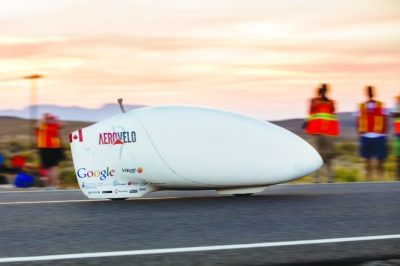Stieber Helps Provide a 'Clutch Performance' in a High-Speed Bike Competition

Humans have an innate thirst for adventure and an instinctive desire to expand their knowledge through firsthand experience. By testing the limits of personal strength and endurance, humans can obtain a better understanding of themselves. One aspect of adventure is the art of competition.
Team AeroVelo, comprised of professionals and engineering students from the University of Toronto, recently pursued this quest for adventure by joining others in an attempt to set the world human-powered speed record.
Every year, teams gather from around the world to compete at the World Human-Powered Speed Challenge (WHPSC) in Battle Mountain, NV. Team AeroVelo brought their newly designed “Eta” speed bike to the 2014 competition. AeroVelo, a design and innovation lab, pursues engineering projects that foster a sense of adventure and passion in scientific development.
“We’re very small and right now our main activities are the student summer projects, public speaking and outreach and limited consulting on wild engineering projects,” stated Cameron Roberston, co-founder of AeroVelo, Inc. “AeroVelo partners with the University of Toronto’s Human-Powered Vehicle Design Team (HPVDT) and shares the team workspace full-time during the summer.”
HPVDT, comprised of U of T undergraduate students in aerospace, materials and mechanical engineering, focuses on the design and construction of innovative, high-performance human-powered vehicles. The goal of the AeroVelo/U of T partnership is to provide students with hands-on, practical engineering design experience that promotes efficiency and sustainability while encouraging the reduction of society’s impact on the environment. Each year the student team has four onths to engineer and build a human-powered vehicle.
“The students’ time at AeroVelo counts toward a 600-hour engineering experience required of all graduates,” Robertson said. “For students, it’s similar to a research internship in a lab, but the design freedom, creative opportunities and time spent in hands-on fabrication are above and beyond what is available elsewhere. This summer, all of the students have been extremely motivated and have very quickly picked up on many of the design concerns and tradeoffs in developing this year’s high-powered speed bike. Students with no specialization in bicycles or aerospace have quickly become familiar with both.”
“Eta,” the name of AeroVelo’s 2014 speed bike, is the Greek letter used in engineering as the symbol for efficiency, and represents the team’s goal of building the world’s fastest human-powered vehicle, capable of breaking the current ground level speed record of 133.8 km/h (83.1 mph).
The speed bike’s internal components are as equally fundamental to the successful performance of the bike as the aerodynamic design. A portion of Eta’s transmission is designed to use a more efficient chain than what is typically used in bicycles.
“Most bicycles have a free-wheel which allows the wheel to rotate even when the pedals and chain are stationary,” said Alex Selwa, a member of the U of T student engineering team. “In our front-wheel drive design we are not using a standard bike chain and cannot use an off-the-shelf bicycle free-wheel.”
The team contacted Formsprag Clutch in Warren, MI to request an overrunning clutch solution. Formsprag, an Altra Industrial Motion company, donated a Stieber CSK25 PP overrunning clutch to the AeroVelo team as part of Formsprag’s Student Support Program. The CSK clutch was chosen in order to accommodate the size and load requirements of the unique hub.
“The front hub design involved fitting many different components into a small and efficient package,” said Selwa. “The clutch needed to be as small as possible in order to fit inside the sprocket and stay within the width requirements of the hub. The clutch is press-fit onto the hub body and then pressed inside of the sprocket. It is responsible for driving the wheels at speeds up to 145 km/h or 90 mph.”
Stieber’s model CSK25 PP is a bearing-supported sprag-type clutch, delivered grease-lubricated and protected against dust particles as small as 0.3 mm. It provides instant locking/engagement when the clutch shifts from overrunning to engagement, with a maximum overrunning speed of 5,000 RPM and a 77.5 lb. ft (105 Nm) torque capacity. The sprag-type backstop keeps the shaft from turning backwards with keyways on both the inner and outer races that prevent the bearing from rotating on the shaft. All CSK clutches feature Formchrome sprags with chromium-infused steel that produces an ultra-hard surface to maximize wear resistance.
With the help of Stieber Clutch, Team AeroVelo’s Eta speed bike reached a top speed of 126 Km/h (78 mph) at the 2014 World Human-Powered Speed Challenge.
“Our goal with Eta is not simply to break a speed record,” stated Todd Reichert, co-founder of AeroVelo, Inc. “Our goal is to reach such unbelievable speeds that it gets people to think twice about preconceived limits of what is possible.”





